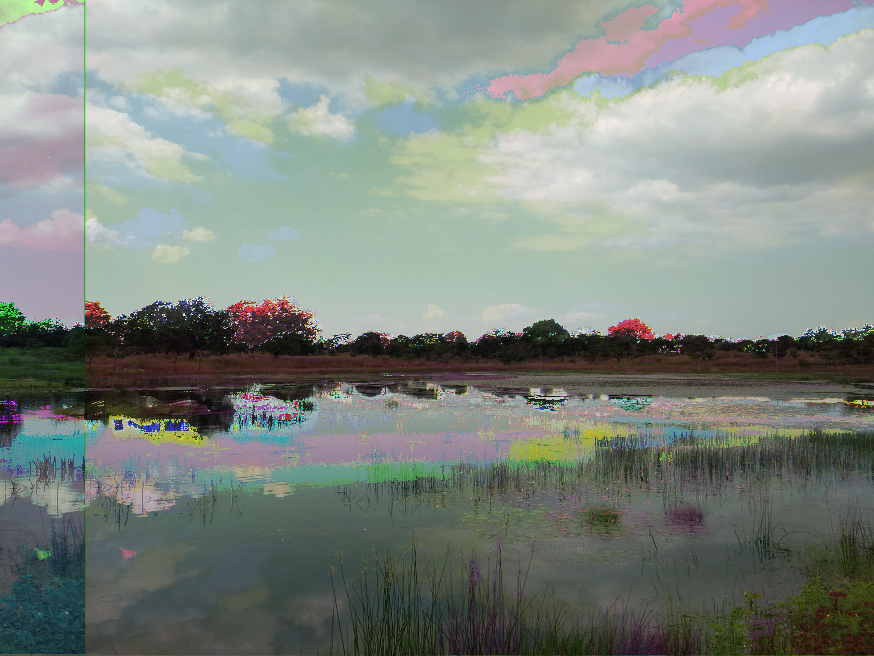Databending images with a command line audio processing utlity
Interesting things happen when you edit images like music. Glitchet lists some resources for how to get started on databending. Using Audacity to databend images is somewhat cumbersome and that is when I found sox. It is called “the Swiss Army knife of audio manipulation” on its man page. Thanks to the sox mailing list where Mr. Rullgård helped me with the commands!
Prerequisites
I am on a Windows 10 computer so I will be using the Command Prompt.
- Sox, I am using v14.4.2 downloaded from Sourceforge
- Added to PATH1, you’ll need to do this to use sox as a command on Command Prompt
- ImageMagick, to make gif from a bunch of images with ‘convert’
Process
In this tutorial, I will use sox to databend an image and then we’ll make 100 versions of that image to make a gif. Everything inside the shell. I am starting with this image, you can start with any image in any uncompressed image format.

Our idea here is to ask sox to apply an audio effect to the image. Sox commands will look like sox [input] [output] [effects]. We need to make sure the files are treated as raw data and also make sure the BMP header is left untouched.
sox -t ul -c 1 -r 48k water.bmp -t ul water_out.bmp trim 0 100s : echo 0.8 0.88 60 0.5
There are a couple of things happening here, let me break it down:
-t ul– We don’t want sox to infer filetype from the filename so this sets the filetype to a headerless raw format ‘ul’. The name ‘ul’ is an abbreviation of μ-law which is an algorithm used in PCM systems.-c 1– Sets number of channels as 1. Although this is default for all raw formats, it doesn’t hurt to set it explicitly.-r 48k– Sets the sample rate to 48ktrim 0 100s :– Skip first 100 samplesecho 0.8 0.88 60 0.5– This follows the format taken from man page,echo gain-in gain-out <delay decay>
We get this image, water_out.bmp

Let’s extend this to make 10 images with a simple loop inside the command prompt, using a for-loop 2
for /l %i in (1,1,10) do sox -t ul -c 1 -r 48k water.bmp -t ul water%i.bmp trim 0 100s : echo 0.8 0.88 %i 0.5
We can also take this further and make 100 images!
for /l %i in (1,1,100) do sox -t ul -c 1 -r 48k water.bmp -t ul water%i.bmp trim 0 100s : echo 0.8 0.88 %i 0.5
Make a gif with all of those images,
convert -delay 10 -loop 0 water*.bmp animate_water.gif
This is the end result,
This was a basic example showing how to work with sox and images, you can of course extend this to all of the audio effects possible with sox. Check out their man page for more examples. Let me know what you make with this!
Added on 8th May, 2018
I posted the gif in the end to /r/Glitch_Art and it reached the subreddit’s homepage! In the comments, /u/ddneva asks something,
ddnava I’m actually more curious about what am I actually watching instead of how to do it
I wrote an explanation as a reply in the comments there but I think it will be helpful if added here too. Pasting my comment as-is
Why This Happens
You’re watching an echo travel across the image as delay is varied. The effect used here took four parameters, it was echo gain-in gain-out delay decay. Think of it as taking every pixel value in the image and processing it through the diagram below,
LibSoX source visualizes it with this ASCII diagram,
* * gain-in ___
* ibuff -----------+---------------------------->| + |
* | _________ | + |
* | | | * decay 1 | + |
* +----->| delay 1 |----------->| + |
* |_________| ---
* |
* | * gain-out
* |
* +----->obuff
As we change the delay value inside the for loop it generates an echo of variable delays. Although this operation doesn’t happen for the image as a whole. But you can as well think of it in terms of a whole image. When I generated 100 images, sox somewhat did this
Image + [Image_Copy(shifted by 1 unit) * gain value]
Image + [Image_Copy(shifted by 2 unit) * gain value]
Image + [Image_Copy(shifted by 3 unit) * gain value] and so on.
Thus, when we put it all back together. It looks like this.
-
You can do this from command line too, open command prompt and type
setx path "%path%;C:\Program Files (x86)\sox-14-4-2"check the directory name to make sure it exists and the version number is correct. ↩ -
Check ‘help for’ inside Command Prompt for the help page. It is also available here. When iterating through a list of numbers, the syntax is ‘for /l %i in (start, step, end) do
' ↩
Leave a comment